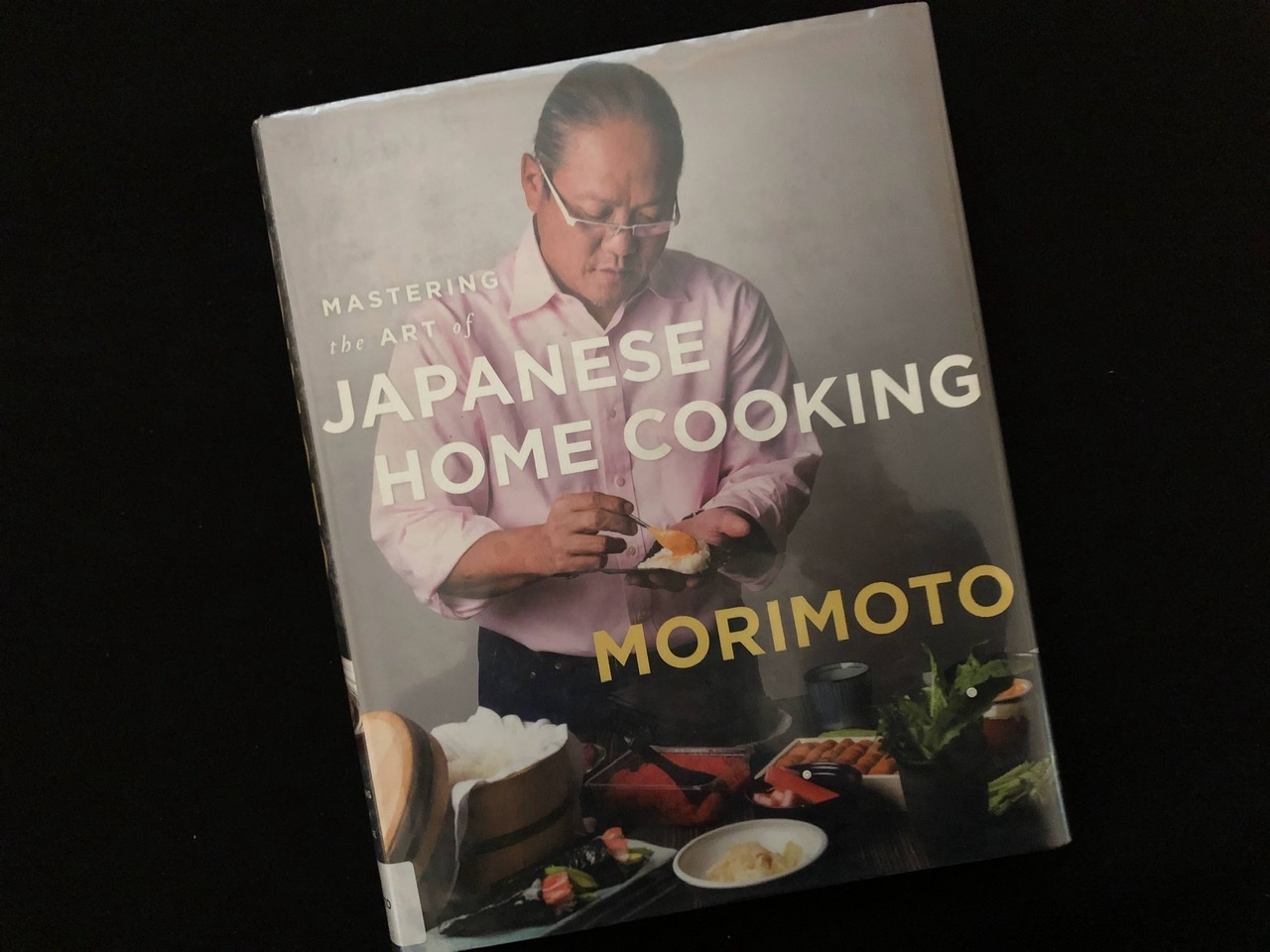
Saturday, May 14 – 12:00pm
In May we used Masaharu Morimoto’s cookbook Mastering the Art of Japanese Home Cooking. In the book the well-known Iron Chef provides recipes for surprisingly simple dishes favored by Japanese home cooks.

Peter was a great host, making several dishes from the cookbook plus a bonus dessert from a different Morimoto cookbook. Mastering the Art of Japanese Home Cooking doesn’t include any desserts, but could we really have a Cookbook Club meal without dessert to finish it off? A few other people also made multiple dishes, so we had a ton of food. There was obviously a lot of excitement for this cookbook!

The Menu

Rayann made Tamago Supu (Japanese egg drop soup). She said it was easy to make, and it was delicious, so I plan to try this recipe out myself. She had this amazing pot which kept the soup hot – something we often struggle with when it comes to soup at our Cookbook Club meals.

Rayann also made Ingen No Goma Ae (green beans with sesame dressing). This was so tasty, and I can vouch for how simple it was to make, as I’ve already made it for myself. It’s only a handful of ingredients, but the sesame flavor is fantastic and the dressing stuck really well to the green beans.

Peter made Tataki Kurie (smashed cucumber pickles). This is a really common side dish that I never mind having around. Crunchy and refreshing – a nice accompaniment to heavier dishes like curry and fried things.

Peter also made Shiozuke (salt pickles). As simple as it gets (basically vegetables brined in salt water), the recipe specifically makes cabbage and radishes but notes you can do this with other vegetables as well. Peter used radishes and turnips, which were great for their crunch.

Eileen made Shira Ae (spinach, carrot, and shiitake with tofu dressing). She was concerned that it lacked flavor, so added more seasoning. Even with the additional seasoning, it was pretty bland. Definitely my least favorite of all the dishes.

Rita made Hijiki (sweet simmered hijiki seaweed). Surprisingly, this was my favorite dish of the meal! I like seaweed and expected it to be an enjoyable side, but had no idea it would be the highlight of the meal for everyone. Morimoto wrote that “seaweed fans and skeptics all love hijiki” – he was right.

Naran made Karashi Ae (brussels sprouts, shrimp, and mushrooms with Japanese mustard dressing). I like brussels sprouts, but feel like they’re almost always done the same way (roasted with bacon and some sweetness). This was a nice way to have them done differently – a solid side or hearty enough to be a main dish.

Rita also made Yakisoba (stir-fried noodles with pork, cabbage, and ginger). The thing I like best about this recipe is it uses packaged noodles and jarred yakisoba sauce. It’s nice to know that great home cooks and even famous chefs don’t need to make everything from scratch when whipping up a meal.

Peter also made Tuna Mayo Onigiri (rice balls). He had a handy onigiri mold which helped him quickly make these perfect shapes – I need to get one of those! Onigiri is so simple, but I love it. Seaweed and rice filled with a tuna mayo mixture makes a perfect snack.

Anthony made Karei Raisu (Japanese-style curry). He also provided rice, which was great to have as a vehicle for getting more sauce into my face. Morimoto says to embrace the premade blocks of Vermont Curry roux, which happily I already use. Usually I doctor mine up a bit, but Morimoto doesn’t do much doctoring in his recipe and it was still pretty good.

Martha made Kara Age (Japanese-style fried chicken with scallion sauce). I love the lighter batter of Japanese fried chicken, but honestly I never fry chicken at home because it uses a lot of oil and makes a mess. So as I happily munched on several pieces, I was very thankful to Martha for making it.

I made Buta No Shogayaki (pork with ginger and onions). The recipe said you could use pork belly or shoulder – I used shoulder. Very simple and fast to make (thinly slicing the pork was the most time-consuming part). People really liked it, and I thought it was tasty but not mind-blowingly good – I was hoping for more ginger flavor.

Peter also made Miso Soufflé’s with Matcha Yogurt Sauce. This wasn’t from the cookbook, but it is a recipe from another of Morimoto’s cookbooks. These tasted as good as they look! I’m always a fan of savory sweet, plus the cold of the matcha yogurt sauce mingled perfectly with the warmth of the soufflé.
The Verdict
At first glance, a cookbook called Mastering the Art of Japanese Home Cooking by a renowned chef like Morimoto seemed somewhat intimidating. It turns out, however, that Morimoto’s goal was to change the perception that Japanese cuisine is intimidating and instead show the simplicity of what a lot of Japanese home cooks are doing. By using ready-made (packaged, boxed, jarred) ingredients in many of his recipes, he succeeded in making me feel like Japanese food is indeed something I can and want to cook at home.
Want in? Join the Cookbook Club mailing list to be notified when new posts go live.














Comments are closed